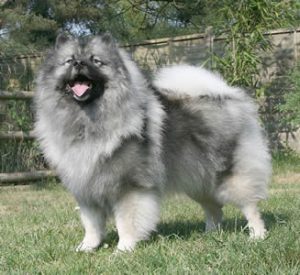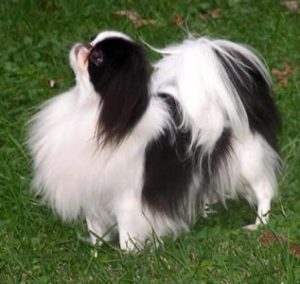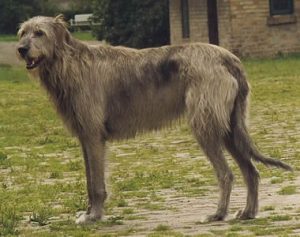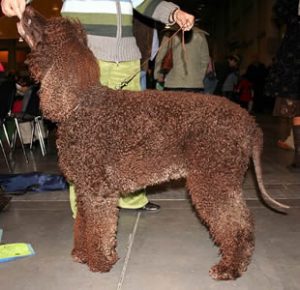
The Keeshond is a medium-sized dog with a plush two-layer coat of silver and black fur with a ‘ruff’ and a curled tail, originating in Germany. Its closest relatives are the other German spitzes such as the Pomeranian. Originally called the German Spitz, more specifically the Wolfsspitz, the name was officially changed to Keeshond in England, where it had been known as the Dutch Barge Dog, in 1926.
Appearance
A member of the spitz group of dogs, the Keeshond in AKC standard is 17 inches (43 cm) to 18 inches (46 cm) tall and 19.25 inches (48.9 cm) ± 2.4 inches (6.1 cm) in the FCI standard and weighs 35 pounds (16 kg) to 45 pounds (20 kg). Sturdily built, they have a typical spitz appearance, neither coarse nor refined. They have a wedge shaped head, a medium-length muzzle with a definite stop, small pointed ears and an expressive face. The tail is tightly curled and, in profile, should be carried such that it is indistinguishable from the compact body of the dog.
Coat
Like all spitz, the Keeshonden have a dense double coat, with a thick ruff around the neck. Typically, the males of this breed will have a thicker, more pronounced ruff than the females. The tail is well plumed, and feathering on the fore and hind legs adds to the soft look of the breed. The coat is shown naturally, and should not be wavy, silky, or long enough to form a natural part down the back.
Colour
The Keeshond is a colour-specific spitz type; many of the names of the dog refer to the distinctive wolf colour of the breed. The colour is a mix of grey, black and cream. The top coat is tipped with black, while the undercoat is silver or cream (never tawny). The colour can range from very pale to very dark, but it should neither be black nor white, and the ruff and “trousers” of the hind legs should be a distinctly lighter silver or cream.
The plumed tail should be of a silver or cream colour with a black tip on the very end. The tail should be tightly curled over the back. The tail is an important part of the Keeshond’s shape. The ears and muzzle are to be black, although some tend to develop “milk mouth” or a white shading around the nose and front of the muzzle. This increases as the dog ages. In American shows, this white shading is acceptable, although not desired.
It is also important to note that the feet are to also be of the same cream, or lighter grey colour as the legs. Feet that are totally black or white are not allowed. However, light pencilling is accepted.
The other important marking is the “spectacles,” a delicate dark line running from the outer corner of each eye toward the lower corner of each ear, which, coupled with markings forming short eyebrows, is necessary for the distinct expressive look of the breed. All markings should be clear, not muddled or broken. Absence of the spectacles is considered a serious fault. The eyes should be dark brown, almond-shaped with black eye rims.
Ears should be small, triangular, and erect.
Temperament
Keeshonden tend to be very playful, with quick reflexes and strong jumping ability. They are quick learners and eager to please. Because Keeshonden are quick learners, they also learn the things you didn’t necessarily wish to teach them – very quickly. However, Keeshonden make excellent agility and obedience dogs. So amenable to proper training is this bright, sturdy dog that Keeshonden have been successfully trained to serve as guide dogs for the blind; only their lack of size has prevented them from being more widely used in this role.
They love children and are excellent family dogs, preferring to be close to their humans whenever possible. They generally get along with other dogs as well and will enjoy a good chase around the yard. Keeshonden are very intuitive and empathic and are often used as comfort dogs. Most notably, at least one Keeshond, Tikva, was at Ground Zero on 9/11 to help comfort the rescue workers. The breed has a tendency to become especially clingy towards their owners, even in comparison to other dogs. If their owner is out, or in another room behind a closed door, they may sit, waiting for their owner to reappear, even if there are other people nearby. Many have been referred to as their “owner’s shadow,” or “velcro dogs”.
They are known by their loud distinctive bark. Throughout the centuries, the Keeshond has been very popular as a watch dog on manors in the Netherlands and middle Europe; this trait is evident to this day, and they are alert dogs that warn their owners of any new visitors. Despite being a loud and alert watch dog, Keeshonden are not aggressive towards visitors. They generally welcome visitors affectionately once their family has accepted them. Unfortunately, barking may become a problem if not properly handled. Keeshonden that are kept in a yard and not allowed to be with their humans are unhappy, and often become nuisance barkers.
—————————————————————————————————————–
CARING FOR YOUR DOG NEWSLETTER – Delivered Directly To Your Inbox – Starting Immediately – SIGN UP FOR FREE TODAY
—————————————————————————————————————–




